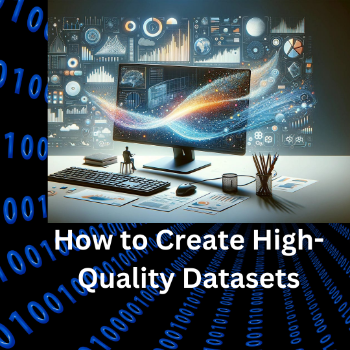Creating a dataset is a crucial step in data science, machine learning, and research, providing the foundation for deriving actionable insights and building precise models. This guide outlines the comprehensive process of dataset creation, from initial data collection to preparation and validation, ensuring effective and informed decision-making.
Steps to Create a Dataset:
1. Define the Objective
Clearly articulate the dataset’s purpose and intended application. This helps in selecting relevant data sources and features.
Key considerations include:
What problem is being addressed?
What types of analysis or modeling are planned?
What are the essential variables or features needed?
2. Identify Data Sources
Gather data from various sources such as public datasets (e.g., Kaggle, UCI Machine Learning Repository), APIs (e.g., Twitter, OpenWeatherMap), web scraping tools (e.g., Beautiful Soup, Scrapy), surveys, and existing databases.
3. Data Collection
Collect data through automated scripts (for APIs and web scraping), manual entry (for smaller datasets), or data export from existing repositories and databases.
4. Data Cleaning
Prepare the dataset by addressing issues such as missing values (through imputation or removal), duplicate entries, errors, and standardizing formats (dates, numbers, strings).
5. Data Transformation
Convert data into an analysis-friendly format by normalizing and scaling values, encoding categorical variables, and performing feature engineering to improve predictive accuracy.
6. Data Integration
Merge data from various sources into a single dataset, using common identifiers, SQL, or other tools to join tables, and resolve any conflicts.
7. Data Validation
Verify the dataset’s accuracy, completeness, and reliability through benchmarking, statistical analysis for outliers and anomalies, and expert review.
8. Documentation
Create comprehensive documentation for reproducibility and usability. This should include metadata on sources, collection methods, applied transformations, a data dictionary with variable definitions, and usage instructions.
9. Storage and Access
Select appropriate storage solutions such as relational databases, data warehouses, or cloud storage services (e.g., AWS S3, Google Cloud Storage, Azure), and use standard file formats like CSV, JSON, Excel, or Parquet.
10. Maintenance
Ensure dataset integrity through regular updates, version control for managing changes, and backup procedures to prevent data loss.
Curated List of Tools for Creating, Annotating, and Managing Datasets:
Top Image Labeling Tools for Accurate Dataset Creation
-
LabeFlow: Open-source tool for annotating images in machine learning projects, enhancing dataset quality.
-
CVAT: Interactive web-based tool for annotating images and videos, optimized for computer vision applications.
-
COCO Annotator: Web tool for image segmentation, object detection, localization, and keypoint annotation.
-
VoTT: Visual Object Tagging Tool for creating object detection models using images and videos.
-
Scalabel: Scalable annotation tool supporting various types of image annotations for versatile applications.
-
EVA: Efficient web-based tool for annotating video and image sequences with integrated tracking features.
-
LOST: Design a customized image annotation process with this web-based tool for tailored dataset creation.
-
Boobs: Fast tool for bounding box (BBox) annotation, supporting YOLO, VOC, and COCO formats.
-
MuViLab: Specialized tool for video labeling tailored to computer vision needs.
-
Turkey: Amazon Mechanical Turk-based web UI for crowd-sourced image segmentation tasks.
Essential Audio Annotation Tools for Comprehensive Data Handling
-
Audio Annotator: JavaScript-based interface for detailed audio file annotation and labeling.
-
Dynitag: Collaborative web tool for annotating audio, facilitating team-based annotation projects.
-
EchoML: Tool for playing, visualizing, and annotating audio files for machine learning applications.
Key Time Series Annotation Tools for Accurate Data Analysis
-
Curve: Platform for detecting anomalies in time series data, essential for experimental analysis.
-
TagAnomaly: Tool for anomaly detection and labeling across multiple time series datasets.
-
time-series-annotator: Implements classification tasks for effective time series data annotation.
-
WDK: Development tools for activity recognition applications using wearable device data.
Top Text Annotation Tools for Enhanced Data Labeling
-
brat: Comprehensive tool for various textual annotation needs.
-
doccano: Open-source text annotation tool designed for machine learning and data labeling.
-
Inception: Semantic annotation platform offering intelligent assistance for text data.
-
NeuroNER: Advanced named-entity recognition tool leveraging neural networks for precise annotation.
-
YEDDA: Tool for annotating text chunks, entities, and events, including symbols and emojis.
-
TALEN: Web-based tool for annotating word sequences with ease.
-
WebAnno: Annotation tool supporting a wide range of linguistic annotations.
-
MAE: Lightweight tool for general-purpose natural language annotation.
-
Anafora: Web-based platform for raw text annotation, ideal for various research applications.
-
TagEditor: Annotates text categories, dependencies, and part-of-speech (POS) for comprehensive analysis.
Source


